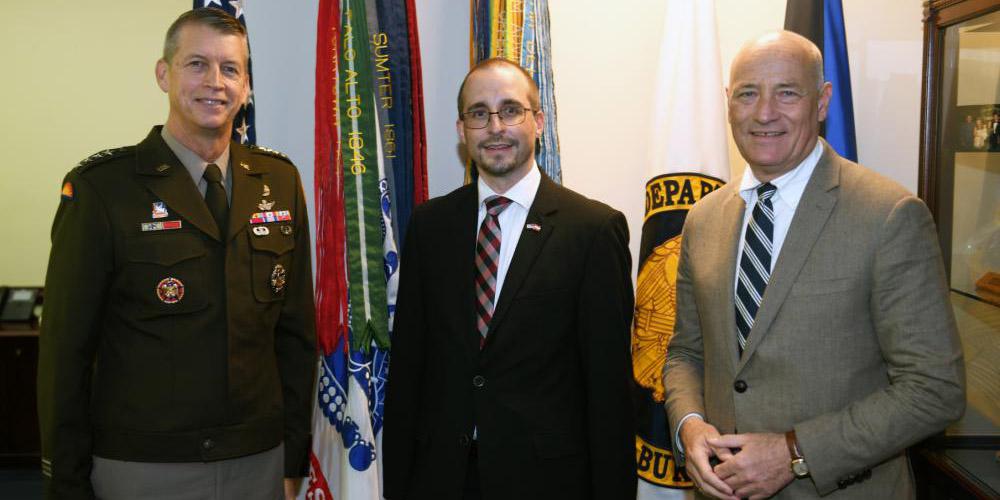National Guard Embraces International Partnerships
The U.S. National Guard has an ever present international mission, with the U.S. state-based militaries growing their relationships with other nations. In some cases, the partnerships with certain countries have been established for decades, shares Gen. Daniel Hokanson, USA, chief of the National Guard Bureau.
The adjutant generals, or leaders of the U.S. state guards, work with a country’s military, their top military leaders and oftentimes directly with the president or ruler of a nation. The partnerships serve as a way to share information, techniques and how the U.S. National Guard responds to national events, medical or natural disasters.
“In 1993 we started with what we call the State Partnership Programs with 13 countries,” Gen. Hokanson explained, speaking to reporters of the Defense Writers Group at a Project for Media and National Security event last week. “Each participating National Guard state teamed up with a country. For example, I was in Bulgaria and Croatia this past week, and Bulgaria was one of the original 13. They paired up with the state of Tennessee. In the course of their 28-year relationship, Bulgaria has gone on to become a NATO ally and a member of the European Union. The Bulgarian military deployed with the Tennessee National Guard in Afghanistan multiple times.”
And because it is common for guardsmen and women to stay in their units for 10, 20 or even 30 years, the foreign partner construct creates key relationships. “All the senior leaders in the Tennessee National Guard have known the senior leaders in Bulgaria and Croatia since many of them were captains or majors,” he said. “They build these enduring relationships that really help both of our countries.”
Gen. Daniel Hokanson, chief of the @USNationalGuard: our long-term efforts with foreign partners are one of the best values for the nation in terms of developing key relationships. #DWG @GWUPMNS pic.twitter.com/1RbTRMQMlO
— Kimberly Underwood (@Kunderwood_SGNL) November 10, 2021
Naturally, the service has to balance its international efforts with its at-home duties, and the list is long: natural disasters, hurricanes, the COVID-19 pandemic, forest fires and political unrest. “Disaster season now lasts all year,” Gen. Hokanson noted.
Despite the demand for the guard’s support, the service has not seen a relative drop in enrollment. “I do watch this very closely, and I’m always worried about that,” he said. “Every year we have a recruiting goal when the fiscal year ends September 30, and we usually meet that goal on September 26, 27, or 28. This year, we actually met it in May. [People] are happy to be doing something of service, to have sense of service.”
Moreover, the size of the U.S. National Guard sometimes surprises people not familiar with the service. It has 445,000 warfighters in all 50 states and three territories. Presently 53,000 guardsmen and women are on duty, 28,000 are forward deployed, 12,000 are assisting with the COVID-19 response and other groups that are doing various commissions around the country, the general reported.
“After 9-11 the National Guard really transformed,” the general said. “And what we are able to do today is because of the investment made in the national guard over the past twenty years. Many of the surprises that we have seen over the past two years, it really defaults to having the right people at the right place. If you look at what we’ve been able to do, we’ve had the resources, the [staffing], the training and equipping to fight our nation’s wars, allows us to be able to do just anything in the homeland.”
However, even though the majority of COVID-19 deaths in the military have come from the guard, leaders recently extended the Army Guards’ COVID-19 vaccine deadline to June 30, 2022. The reason is the disperse nature of the service, Gen. Hokanson stated.
“For the Air National Guard, the deadline is in December and the Army National Guard is in June next year,” the general explained. “When we look at the main differences, the Air Guard is base centric. The Army Guard is a little different. We are looking at really 2800 communities across the United States… and they could be dispersed with units as small as 30 or as large as 600. The reason why we had asked for more time with the Army Guard [getting the vaccine] is to get out to all of those units. And at the time the decision was made, Pfizer was the only vaccine that they could mandate.”
Rear Adm. John Kirby, USN (Ret.), assistant to the secretary of defense for Public Affairs, responded to the November 2 plan of Oklahoma Gov. Kevin Stitt—backed by Brig. Gen. Thomas Mancino, the newly named but not yet confirmed adjutant general of Oklahoma—to not require vaccine mandates for that state’s Guard. In a November 15 press conference, the DOD spokesman said that COVID-19 vaccinations were a force readiness issue. He confirmed that the secretary of defense, as well as the service secretaries, have the authorities to establish readiness requirements for all members of the Department of Defense, including the National Guard.
“The Secretary has the authority to require these vaccines for all members of the force, including the National Guard, and even in a Title 32 status.” Adm. Kirby stated. “Because when they're called up for their monthly training, they're still federally funded. So, he has those authorities. And he believes and this is a larger point that a vaccinated force is a more ready force.”





Comments